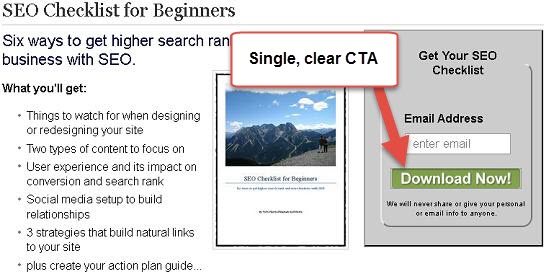Last updated on August 21st, 2020 at 03:00 pm
Conversion is the fervent goal of every web marketer. Anyone who claims otherwise has either gotten his job description wrong or has too much money to burn.
While working hard towards improving conversion rates of existing websites and landing pages is one thing, it’s a lot better to get things right the first time. Build it right and the results will follow.
This is especially true in the case of a landing page – a single page that carries the responsibility of converting all your advertising dollars into actual revenue – the last runner in the marketing relay race.

Let’s take a look at what you need to take care of before your star relay runner gets the baton handed to him/her.
1. Who do I hope will arrive on my landing page?
Do you have a high bounce rate? Is the time spent on your landing pages lower than low can get? One key reason for a high bounce rate and low time spent on page, is that the wrong users are landing on your page.
Getting people to your landing page can happen in a number of ways. Email, social media posts, banner ads, text ads and so on. If you don’t really care who ends up on your landing page, any route you take to get them there works just fine. But in most cases, you have a clear target customer in mind.
Chalk out the various aspects of this target customer’s profile – how old are they, are they male or female, which part of the world do they live, what websites do they frequent and so on. Based on a comprehensive demographic and psychographic profile, pair your landing page to the right type of ad, email or post to attract the appropriate persona of customers to your landing page.
2. What is the customer looking for?
So you’ve got the customer profile down pat. But are you giving your perfect customer what they’re looking for? If your landing page gets the right people but offers them something that has nothing to do with their profile or interests, you’re bound to lose those users forever.
Mine the customers’ profile information to offer relevant content. A dating website for heterosexual people ought to use the gender information of their user and show content related to the opposite sex to stay meaningful.
Another approach is to infer the probable interests of users based on their profile information. Give your users what they might be most interested in. For example, a landing page for a laptop manufacturer that targets middle school teachers could talk about helping children learn through multimedia methods, the connected web, and the ease of sharing data when the entire class is connected online.
A good way to serve up content that works well with specific user types is to understand the keywords that your target customer searches for and build your landing page content around these keywords. Target these keywords in your SEM and SEO campaigns to reel in the right users. Tools like Google’s Keyword Planner offer a free option of zeroing in on keywords that are relevant and will resonate with your audience. Here’s a great post on how to use the Keyword Planner efficiently for the best converting keywords. Here’s another to help you zero in on the right keywords and relevant search terms with other tools.
Another clue to building relevant landing pages is the source from where the user arrived on your page. Did they come from a social networking site? Make sure your social sharing icons are upfront and clearly visible. Did they come from an email that you sent out? Ensure that the landing page content matches what you spoke of in the email.
Tools like Personyze and Monetate help you customize your landing page content and serve up relevant content to the right audience.
3. Is my landing page relevant to my ad?
When the contents of your marketing email do not match the subject line that you opened the message with, you can actually be prosecuted under the CAN-SPAM Act in the United States. Unfortunately, there is no such regulation for banner or text ads that lead you to a completely misleading landing page.
The repercussion that you would suffer in such a case is that the customer will feel cheated and would never click on one of your ads again. The other possibility is, that if you keep this up long enough, you could be penalized by Google as a spammy marketer.
Make sure your ad and landing page speak the same language and convey the same message.
4. Does my landing page copy confuse or convert?
You caught the user’s eye. You managed to get them to click on your ad/email and brought them all the way to your landing page. The clincher in getting your user to convert into a real customer is the copy on your landing page.
Make sure your headline is strong and catchy, with a hook that forces the customer to read the rest of the message. Stick to one message per landing page. The greater the variety of information on your landing page, the greater are the chances of ending up with a puzzled customer who eventually drops away from the page.
Don’t scare the user away with reams of content on your landing page. Keep it simple and clear. Use bullet points wherever possible.
5. Is my CTA clear?
Just as your landing page ideally should have one central idea or theme, there MUST NOT be more than one call to action per landing page. There are many things that you might want a customer to do when they land on your site. But you need to prioritize the actions that you want a customer to take. What is your money shot? Is it asking the customer to ‘Register now’? Is it asking them to ‘Start a free trial today’? Pick your most important CTA and highlight it loud and clear on your page.

Use a button if you like for your CTA, but make sure you have your CTA as a text URL in your landing page copy for those rare cases when a browser does not display your button (bye, bye CTA!)
Another thing to keep in mind is to describe the actual action you want the customer to take in your CTA. Something like ‘Subscribe to our free newsletter’ makes more sense that simply saying ‘Click Here’ or ‘Know More’ as your CTA.
6. Should I make separate landing pages for each source of visitors?
It is a well-known fact that different media platforms cater to very different types of customers. If you sell the same product that caters to these very disparate types of customers, you are better off creating separate landing pages that match the sensibilities of each customer type than making one giant one-size fits all type page that appeals to nobody.
Don’t worry about splitting your page metrics. There are many ways to capture which source your conversions come from. Google Analytics has campaign tagging to help you identify how much each source or channel contributed to the topline. If you’re an ecommerce retailer, Shopify’s retail POS even combines offline and online touch-points and makes managing multi-channel sales a real breeze.
Wrap up
If an ad is the window to your store, a landing page is the actual store itself. A place that advertises itself as a bookstore just to attract customers but actually sells coffee instead, is never going to make any money.
Keep your landing page true to the soul of your business. Make it simple to understand and quick to navigate and you’ll see that customers find their way to the cash register pretty quick.
Tracy Vides is a content strategist and researcher who gives small business and entrepreneurs marketing and social media advice. Tracy is also a prolific blogger – her posts are featured on Techvibes, She Owns It and Sprout Content. Connect with her on Twitter @TracyVides for a chat anytime!
3 replies to "6 Hard Questions Marketers Should Ask Before Customers Get to Your Landing Page"
Hi guys,
I got to agree with the part about clear CTA. At times, I’m also confused on that. Having a bright, clear colour CTA doesn’t guarantee an excellent conversion and it could even puzzle / confuse your readers.
Sometimes, the most simple ones work!
So yes, great guide and thanks for sharing.
Hi Reginald,
Sometimes finding that single, clear, CTA takes some trial and error… which might mean doing some A/B split testing on different CTAs to find the one that gets the best response.
I really agree with these phrase ‘The greater the variety of information on your landing page, the greater are the chances of ending up with a puzzled customer who eventually drops away from the page.’